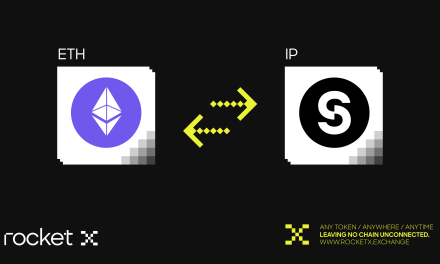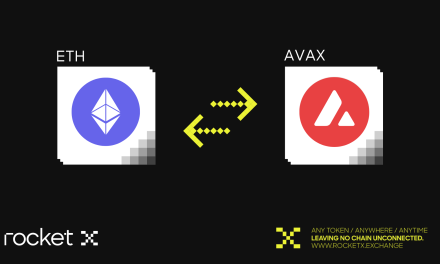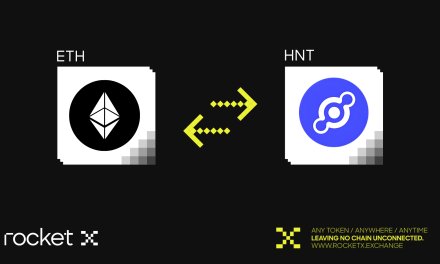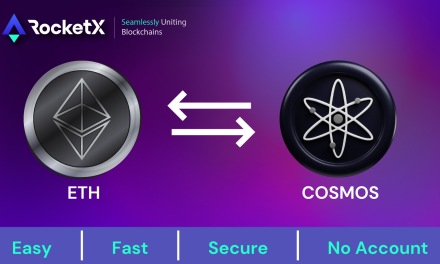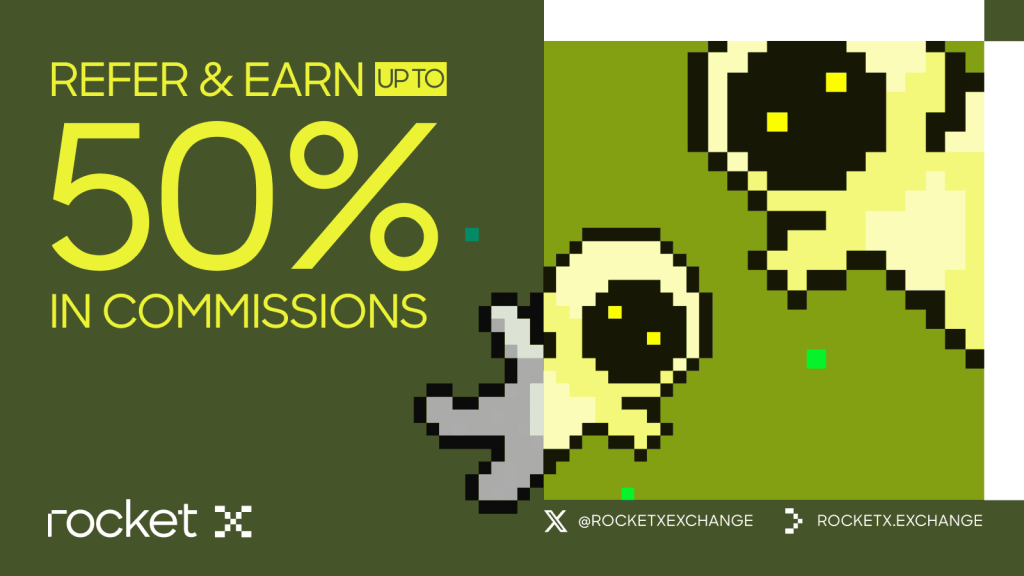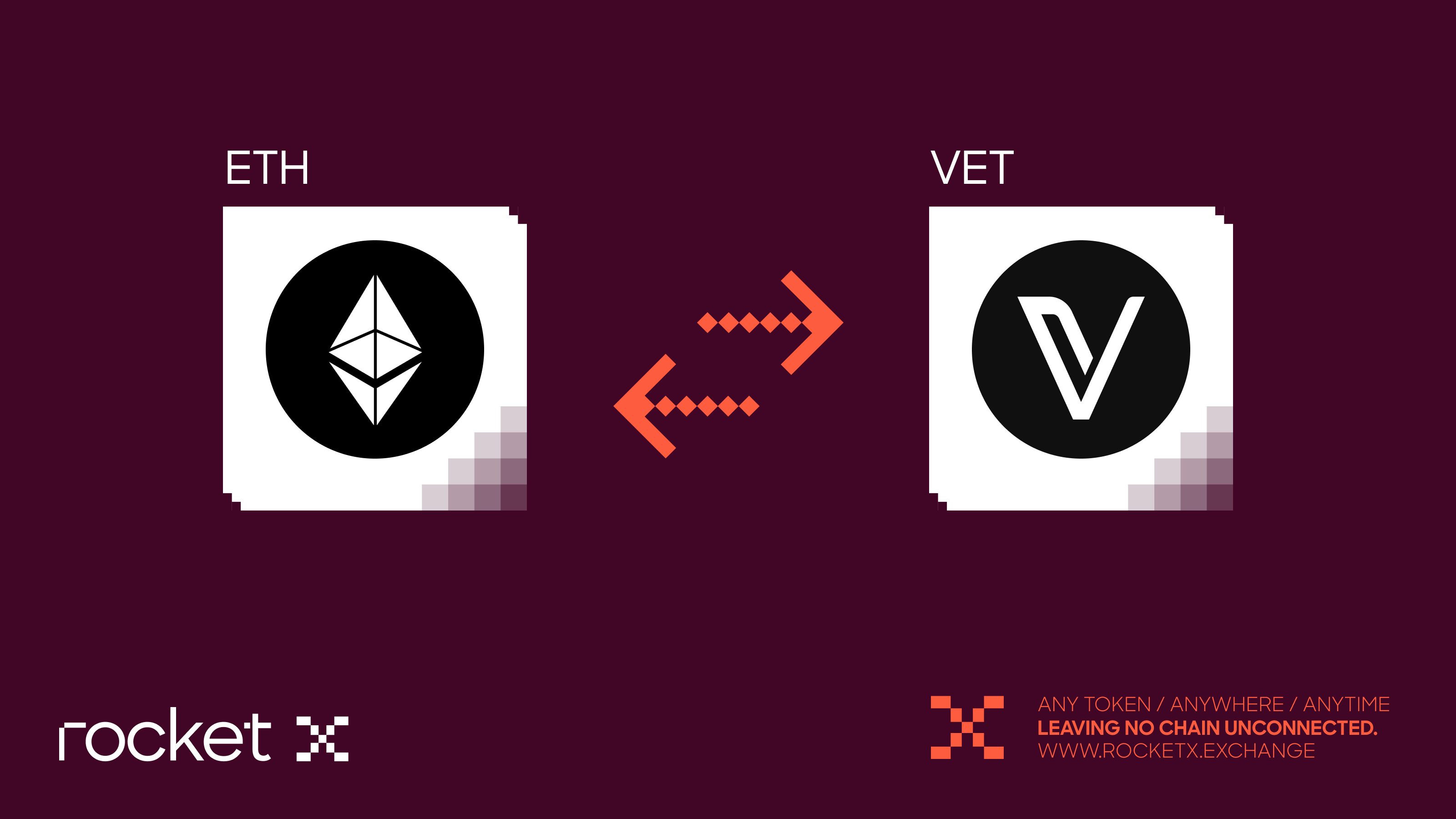
Introduction
The world of blockchain is evolving rapidly, with projects now going beyond finance to tackle real-world industry challenges. Among them, VeChain (VET coin) stands out as a pioneer. Designed to revolutionize supply chain management and enterprise adoption, VeChain has become a trusted blockchain solution for businesses across logistics, sustainability, healthcare, and luxury goods.
With increasing partnerships, real-world integrations, and growing investor interest, questions like “What is VeChain?”, “Is it a good investment?”, and “How do I buy VET?” are trending among crypto enthusiasts. In this article, we’ll explore VeChain’s mission, technology, tokenomics, partnerships, and future potential. Finally, we’ll guide you step-by-step on how to buy VET tokens using RocketX Exchange—your all-in-one cross-chain liquidity aggregator.
What is VeChain ?
Launched in 2015 by Sunny Lu, a former CIO of Louis Vuitton China, VeChain (VET) began with a clear mission: to use blockchain technology to improve transparency, trust, and efficiency in global supply chains.
The project helps businesses track products and data throughout their lifecycle—ensuring authenticity, preventing fraud, and optimizing logistics. Unlike purely financial crypto projects, this blockchain focuses on real-world enterprise adoption.
- Founders & Team: Sunny Lu co-founded the network with the support of the VeChain Foundation, based in Singapore.
- Mission: Bring blockchain to businesses in a way that solves real problems like counterfeiting, inefficiencies, and data silos.
- Token System: The ecosystem uses a dual-token model—VET (value transfer) and VTHO (gas for transactions).
Simply put, VeChain bridges the gap between blockchain and real-world industries.
How VeChain Works
VeChain is designed as a blockchain platform for enterprises, focusing on real-world adoption in industries like supply chain, logistics, healthcare, and sustainability. Its working model is unique because it combines blockchain with IoT (Internet of Things) and a dual-token economy.
At the heart of VeChain is its dual-token system:
- VET Token: The main token used for transferring value, staking, and governance.
- VTHO Token: Generated by holding VET, it functions as “gas” for transactions. This model keeps transaction costs predictable and low, making it easier for businesses to adopt without worrying about volatile fees.
It uses Proof of Authority (PoA) consensus, where trusted authority nodes validate transactions. Unlike Proof of Work (Bitcoin) or Proof of Stake (Ethereum), PoA is faster, energy-efficient, and ideal for enterprise-level solutions. With only 101 authority nodes, VeChain achieves scalability, speed, and security while maintaining decentralization at the enterprise level.
Another key feature is VeChain ToolChain™, a platform that allows companies to build blockchain applications without deep technical knowledge. For example, a luxury brand can add RFID chips or QR codes to products, which customers can scan to verify authenticity on VeChain’s blockchain.
By combining blockchain, IoT devices, and enterprise partnerships, it provides businesses with a transparent and tamper-proof way to track goods, verify origin, and share trusted data across global supply chains.
In simple words, VeChain works by making blockchain practical and accessible for real-world businesses.
Everything You Need to Know About VET and VTHO Tokens
VeChain runs on a dual-token model, which is one of its biggest strengths. Unlike many blockchains that rely on a single token for everything, it separates value transfer (VET) and transaction fees (VTHO) to create stability and usability for enterprises.
What is VET?
VET is the primary cryptocurrency of the VeChain ecosystem, designed to function as both a store and a transfer of value across the network. Beyond simple transactions, it plays a central role in maintaining the blockchain’s operations. Holding VET allows users to participate in staking and community governance, giving them a say in important network decisions. One of its biggest advantages is that it automatically generates VTHO, the secondary token that powers transactions on the VeChainThor blockchain. This means long-term holders not only support the ecosystem but also earn passive rewards. For enterprises, VET is used as a payment token when accessing blockchain services, while for individuals it represents a way to secure influence in governance and generate additional utility through VTHO. In short, VET is the fuel tank that keeps the entire VeChain network running.
What is VTHO?
VTHO (VeThor Token) is the secondary token within the VeChain network, designed to function much like gas fees on Ethereum. It is automatically generated when users hold VET, meaning every VET token continuously produces VTHO over time. The main purpose of VTHO is to cover transaction costs on the VeChainThor blockchain, ensuring that enterprises can operate without facing unpredictable fee spikes. This dual-token model keeps costs stable and low, allowing companies to focus on using the technology rather than worrying about price volatility. In essence, VTHO makes VeChain practical for real-world adoption by providing a reliable and cost-efficient way to process transactions.
Why the Dual-Token Model Matters
- Stability: Businesses don’t face unpredictable fee spikes.
- Scalability: VET investors earn VTHO rewards, encouraging long-term holding.
- Adoption: Enterprises can integrate blockchain solutions without worrying about volatility.
In short: VET is for value and staking, while VTHO powers transactions. Together, they make VeChain an enterprise-friendly blockchain.
Major Partnerships & Ecosystem Growth
This isn’t just another blockchain project—it’s a real-world solution trusted by global enterprises. The network’s growth story is built on high-profile partnerships and a forward-looking ecosystem that continues to expand. Here are some of the standout collaborations:
- Walmart China – Tracks food products on the blockchain to guarantee authenticity and freshness, giving customers full transparency from farm to shelf.
- PwC (PricewaterhouseCoopers) – Brings blockchain services to enterprise clients worldwide, enhancing supply chain security and efficiency.
- DNV – Uses the technology for audits, sustainability tracking, and digital assurance tools like MyStory™, ensuring data remains tamper-proof.
- BMW – Verifies car parts on-chain to reduce fraud and ensure product quality.
- UFC – Embeds NFC chips into gloves to authenticate memorabilia—blending sports and blockchain innovation.
Fresh Highlights: 2024–2025 Updates
- Wanchain Partnership (June 2025): Unlocks cross-chain interoperability, linking VeChainThor with over 40 major networks and boosting its utility across the decentralized web.
- VeBetterDAO & VeWorld Wallet (2024–2025): Expands the ecosystem with “X to Earn” apps rewarding sustainable behavior, while the VeWorld Wallet serves as a central hub for users.
- Stella Pay & 4ocean (2025): Introduces real-world spending of tokens via Stella Pay and transparency in environmental cleanup efforts with 4ocean.
Why It Matters
These partnerships highlight working blockchain applications in supply chain, sustainability, sports, and cross-chain finance. With initiatives like Wanchain bridging networks, VeBetterDAO promoting eco-friendly incentives, and 4ocean driving environmental accountability, the VeChain ecosystem is proving itself as future-ready and impactful.
How to Buy VET or VTHO Tokens Using RocketX Exchange
With VeChain’s ecosystem rapidly expanding through global partnerships in supply chain, sustainability, and cross-chain finance, more investors are exploring how to get started with VET and VTHO tokens. Whether you’re looking to hold VET coin for long-term growth or need VTHO to cover transactions, the process is straightforward with RocketX Exchange.
RocketX is the world’s first hybrid liquidity aggregator that connects liquidity across 190+ blockchains. This means you can seamlessly buy VeChain (VET) or VeThor (VTHO) from any network, all in one place, with the best available rates.
Step-by-Step Guide:
- Open RocketX & Connect Source Wallet
Open app.rocketx.exchange and connect the wallet that holds the funds you’ll use (e.g., MetaMask/Rabby for EVM, Phantom for Solana, etc.). - Choose Your Source Network and Token
In the From field, select the blockchain and token you want to swap (e.g., ETH on Ethereum, USDT on BNB Chain, or SOL on Solana).
Example: In this guide, we’re using the Ethereum Network and the ETH Token, but you can choose any network and token. - Set Destination Network and Token
In the destination box, select VeChain Network and choose either VET or VTHO as the token you want to receive. - Paste Your VeChain Wallet Address
Copy your receiving address from a VeChain-compatible wallet and paste it into the destination field. - Enter Amount & Get Best Route
Type the amount. RocketX automatically aggregates routes across CEX+DEX liquidity to fetch the best price and lowest fees.
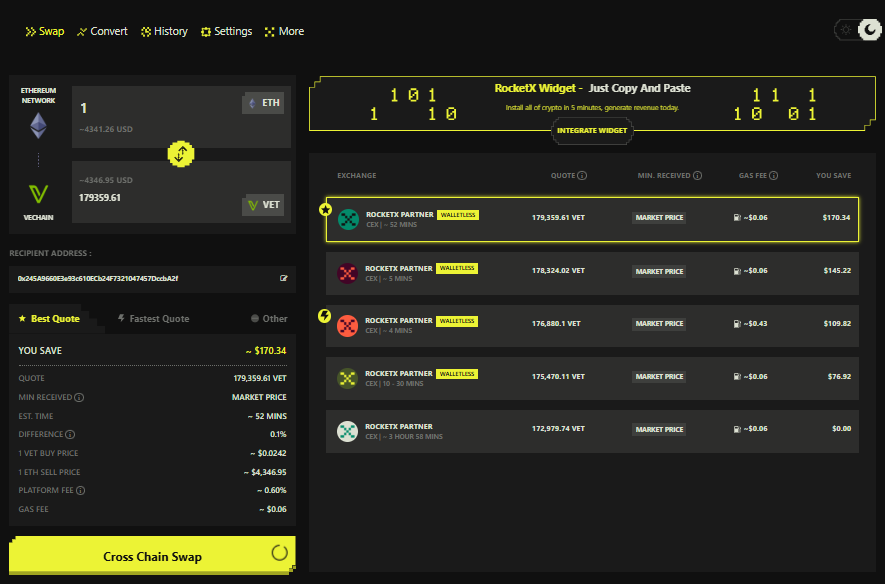
6. Review and Confirm Transaction Details
Verify all details, including network names, token amounts, and estimated fees. Once satisfied, click “cross-chain swap” and approve the transaction via your connected wallet.
7. Complete the Bridge
RocketX will now handle the bridge and swap process automatically. Your tokens will arrive on the Vechain network within minutes.
With RocketX Exchange, buying VET or VTHO is fast, making it the most flexible way to invest in the ecosystem.
Future Potential of VeChain
The outlook for VeChain (VET) is promising but should be considered with a balanced view. On the positive side, the project has carved out a strong niche by focusing on enterprise adoption rather than hype-driven narratives. Its technology is already used by global brands like Walmart China, PwC, and DNV, proving that blockchain can deliver real-world value. As regulations around digital assets become clearer, this network is well-positioned to attract more enterprise clients, especially in supply chain, healthcare, and sustainability sectors.
Another major strength is the VeCarbon platform, which aligns with the global push for sustainability and ESG reporting. With governments requiring companies to track and reduce carbon emissions, this initiative positions the project as a potential leader in blockchain-powered sustainability. Its ability to integrate with IoT devices and AI also opens doors for next-generation applications in logistics, manufacturing, and data automation.
However, challenges remain. Enterprise adoption is often slow and cautious, meaning growth may not match the speed speculative investors expect. The price of VET still depends heavily on broader crypto market cycles, making it vulnerable to downturns. Competition is also growing, with other blockchains developing supply chain and sustainability-focused solutions.
In short, the project has strong fundamentals and unique positioning, but its long-term success will depend on enterprise adoption speed, regulatory clarity, and overall market conditions. For long-term investors, it’s a blockchain worth watching with cautious optimism.
Conclusion
VeChain has established itself as more than just another crypto project—it is a blockchain built for solving real-world problems. With its dual-token model (VET & VTHO), enterprise-first approach, and partnerships with global giants like Walmart China, PwC, BMW, and DNV, VeChain continues to demonstrate practical use cases in supply chain, sustainability, and beyond.
While challenges such as market volatility and slow enterprise adoption remain, VeChain’s strong fundamentals and growing ecosystem make it a project worth watching closely. For those who want to be part of its journey, RocketX Exchange offers the simplest way to buy, swap, and bridge VeChain tokens across 190+ blockchains—all in one place.


